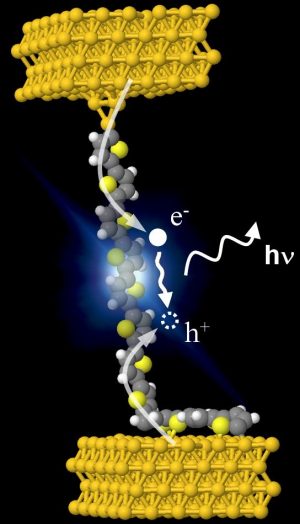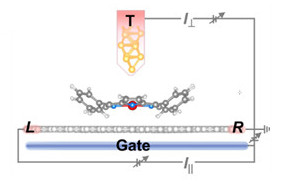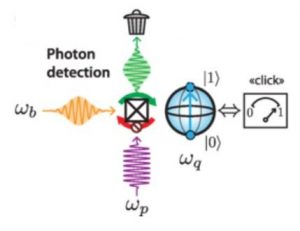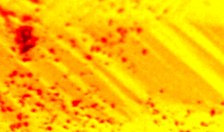With organic and molecular electronics, a data processing based on various types of nano-objects (molecules, biomolecules, nanoparticles, carbon nanotubes, graphene,…) is emerging.
This means developing:
- The synthesis of new molecules and new nano-objects
- Methods of chemical functionalization of nano-objects (graphene, NPs, nanotubes, C60) for the formation of hybrid materials with new or improved properties
- Assembly methods of nano-objects on surfaces
- Nanofabrication techniques to connect individual nano-objects
- Electronic transport measurements
- New operating strategies of the electronic properties for the implementation of new functions
- Theoretical efforts to model the studied devices and to propose new structures with original properties.
In the case illustrated here, one single molecule is connected to two electrodes spaced by 1 to 3 nm, the objectives are to master and understand the metal-molecule interface and the properties of the so positioned molecule. On this principle, single molecule LEDs have recently been studied: “Electroluminescence of a single polythiophene molecular wire suspended between the tip and the surface of a scanning tunneling microscope”, © Guillaume Schull – IPCMS – CNRS / Université de Strasbourg.

Three experimental topics in organic electronics are carried by the NIMBE/LICSEN team :
- Carbon nanotubes are one example of elementary objects used in molecular electronics. The manufacture of devices and circuits involving carbon nanotubes requires control of their positioning on a surface and their interconnection. The self assembly of nanotubes on a surface locally functionalized chemically is a technique that allows the manufacture of elaborated circuits.
- Printed electronics where grafting processes via organic molecules allows maunfacturing conductive circuits at very low cost (RFID chips, complex circuits, sub-micron conductive tracks…)
- The organic spintronics, where it was shown that the magnetic decoupling of metal thin layers can be achieved with a single organic monolayer.
Finally, aging studies by irradiaton of organic components (MADIR team of CIMAP, Caen) complete the research in this area.













